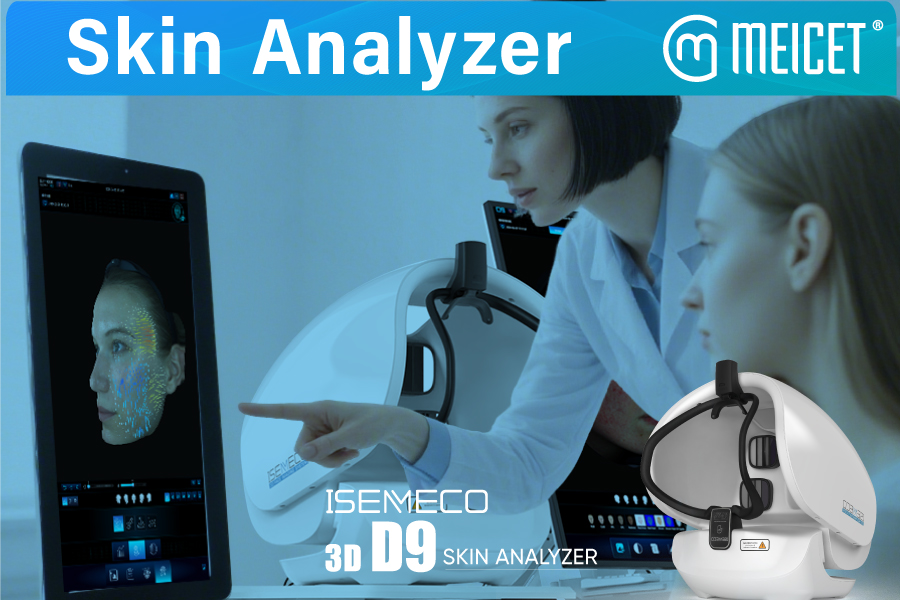The rapid integration of skin analyzers into clinics, spas, and homes represents a significant shift in dermatological assessment. At the core of this transformation lies sophisticated technology designed to reveal what the naked eye cannot perceive. Understanding the principles behind these devices, exemplified by platforms like the MEICET skin analyzer, demystifies their growing role in skin health management.
Fundamental Principle: Light Interaction with Skin
The bedrock of modern skin analysis is the science of light interaction with biological tissues. Human skin is a complex, multi-layered structure. Different wavelengths of light penetrate to varying depths and interact uniquely with cellular components and molecules. Visible light primarily reflects off the skin’s surface, revealing texture and overt discoloration. However, deeper layers harboring critical information about hydration, collagen density, vascular health, and pigmentation irregularities require probing with specific light spectra beyond the visible range.
Multi-Spectral Imaging: Seeing Beyond the Visible
This is where multi-spectral imaging becomes pivotal. Contemporary skin analyzers, including representative systems like the MEICET skin analyzer, employ an array of light sources and specialized sensors:
Standard Visible Light (RBG): Captures surface topography, fine lines, wrinkles, pore size, and overall complexion evenness under controlled, consistent lighting.
Cross-Polarized Light: Effectively eliminates surface glare (specular reflection) caused by oils or moisture. This allows clear visualization of sub-surface redness, inflammation (erythema), and vascular structures like telangiectasia (broken capillaries), crucial for assessing conditions like rosacea or irritation.
Parallel-Polarized Light: Enhances the visibility of surface texture details, including micro-relief lines, scaling, and subtle roughness.
Ultraviolet (UV) Light (Wood’s Lamp Principle): Causes certain skin components to fluoresce. This reveals accumulated sun damage (often appearing as distinct dark spots before they surface clinically), fungal infections, bacterial presence (like P. acnes), and variations in pigmentation depth that are invisible under normal light. UV imaging highlights photoaging and potential precancerous changes.
Near-Infrared (NIR) Light (Emerging): Penetrates deeper into the dermis, potentially visualizing collagen structure, deeper hydration levels, and significant subdermal vascular networks.
The MEICET skin analyzer, as a contemporary example, integrates such multi-spectral capabilities. During an analysis, the device sequentially or simultaneously emits these different light types onto a precisely targeted area of skin. High-resolution cameras equipped with appropriate filters capture the distinct responses – reflection, absorption, scattering, and fluorescence – across these spectra.
From Raw Data to Meaningful Biomarkers: The Role of AI
Capturing multi-spectral images is only the first step. The immense volume and complexity of the raw optical data require sophisticated computational power to translate into actionable insights. This is where artificial intelligence, particularly deep learning algorithms, becomes indispensable.
Image Processing & Feature Extraction: Algorithms first preprocess the images, correcting for minor variations and aligning data from different spectra. They then meticulously identify and quantify key features: the intensity and distribution of melanin (brown pigment), hemoglobin (red pigment, indicating blood flow and inflammation), collagen patterns (inferred from light scattering), pore characteristics, wrinkle depth and density, moisture levels (inferred from light reflection properties), and the presence of specific fluorescent signatures.
Pattern Recognition & Biomarker Mapping: By comparing the extracted features across the multi-spectral dataset, AI constructs a comprehensive map of skin biomarkers. It identifies correlations invisible to humans – for instance, how sub-surface UV damage correlates with surface texture changes, or how localized inflammation affects nearby collagen structure.
Comparative Analysis & Trend Identification: The system references the analyzed data against vast, anonymized datasets derived from diverse skin types and conditions. This allows it to identify deviations from normative ranges, pinpoint areas of concern (like atypical pigment networks or vascular clusters), and track subtle changes in these biomarkers over sequential scans. The MEICET skin analyzer leverages such AI to generate comparative reports highlighting progression or regression in key skin health indicators.
Visualization: AI synthesizes the complex multi-spectral data into intuitive visual outputs for users and professionals. This includes false-color maps overlaying the skin image to show pigment concentration, vascular activity, or sun damage zones, and 3D topography models illustrating texture and wrinkle depth.
MEICET: Integrating Principles for Holistic Assessment
The MEICET skin analyzer embodies the convergence of these core principles. It functions as a multi-modal sensor platform, systematically acquiring data through controlled multi-spectral illumination. Its integrated AI engine performs the critical tasks of data fusion – combining insights from RBG, polarized, and UV imaging – to generate a unified, layered assessment of the skin’s condition. The platform focuses on delivering quantifiable metrics for critical biomarkers associated with aging, hydration, pigmentation, vascular health, and texture, providing a baseline and enabling objective progress tracking.
Beyond the Snapshot: The Promise of Longitudinal Analysis
A key advantage of this technology-based approach is its suitability for longitudinal monitoring. By capturing highly standardized, quantified data at each session, devices like the MEICET skin analyzer allow for precise comparison over time. This is invaluable for objectively assessing the efficacy of skincare regimens, professional treatments, or monitoring chronic conditions for subtle changes that might escape routine visual inspection. The consistent, data-driven nature reduces subjectivity inherent in traditional visual assessments.
Conclusion: Illuminating Skin Health
Skin analyzers are not merely advanced cameras; they are sophisticated bio-optical sensor systems powered by artificial intelligence. Their principle operation hinges on exploiting the interaction of specific light spectra with skin layers and utilizing advanced computation to decode the resulting complex signals into meaningful, quantifiable biomarkers of health and aging. Platforms like the MEICET skin analyzer demonstrate how the integration of multi-spectral imaging and deep learning translates light into actionable knowledge, moving skin assessment beyond surface observation towards a more objective, data-informed understanding of skin biology. As this technology continues to mature, its potential to enhance preventative care, personalize treatments, and objectively track skin health becomes increasingly significant.
by Irina
Post time: Jul-08-2025









